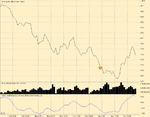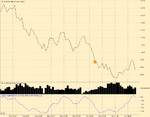Getting back to CAPM .......
Firstly may I take this opportunity to emphasise my agreement with Grey1's approach using Fundamentals as the way to determine weak and strong stocks. When I started out in trading and investing years ago I was fortunate to come across this principle early on and it works - period.
If you were going to bet on a football team to win a Premier League match, would you choose Arsenal or Derby ? And if you were going to pick a team to lose a match, which would you pick ?
If you pick Arsenal to lose then most of the time you will be wrong.
Why back a winner to lose ? Why back a loser to win ?
So before you place your bet you need to understand what you are betting on. That is why Fundamentals are so important when you are risking your money on stocks.
If you think you can rely on Technical Analysis alone for trading stocks, then you are taking unecessary risks with your money. Trading is hard enough for many as it is, so why make it harder ? Would you choose to drive your car using only one hand, or bald tyres or no brakes ?
Apologies if I am teaching grandmother to suck eggs, I mean no disrespect to those who already accept these principles, but this concept is so important that it must be emphasised for those who do not.
After researching the topic further, here is a basic procedure for calculating the projected value of a stock based on Capital Asset Price Modelling. Comments/criticism welcomed:-
The data you need for this are:-
1. The stocks Beta. B
2. The stocks Dividend amount D
3. The risk-free rate of return, represented by something like the yield of the 30 year Treasury Bond. RFR
4. The Average return of the Market. AR
First calculate the CAPM C:-
C = RFR + (AR - RFR) x B
Then calculate the Value of the stock i.e. the Target Price T, usind the Dividend Valuation Model:-
T = D / CAPM expressed as a decimal.
Example:
B = 1.1
D = 40c
RFR = 6%
AR = 10%
C = 6 + (10 - 6) x 1.1
= 10.4 % or 0.104
T = 40c / 0.104 = 385c = $3.85
If the anticipated next dividend is 20c instead of the current 40c, then
T = 20c / 0.104 = 192.5 or $1.925.
(Current values of RFR and AR for the US market are 5.68% and 12% respectively.)
Once you have a target price you can determine whether there is enough of a difference (Reward) between the current price and the target price to justify taking a position.
Then you can use the top-down approach (Market first, Stock second) of Technical Analysis to determine when to enter and when to exit.
Glenn


